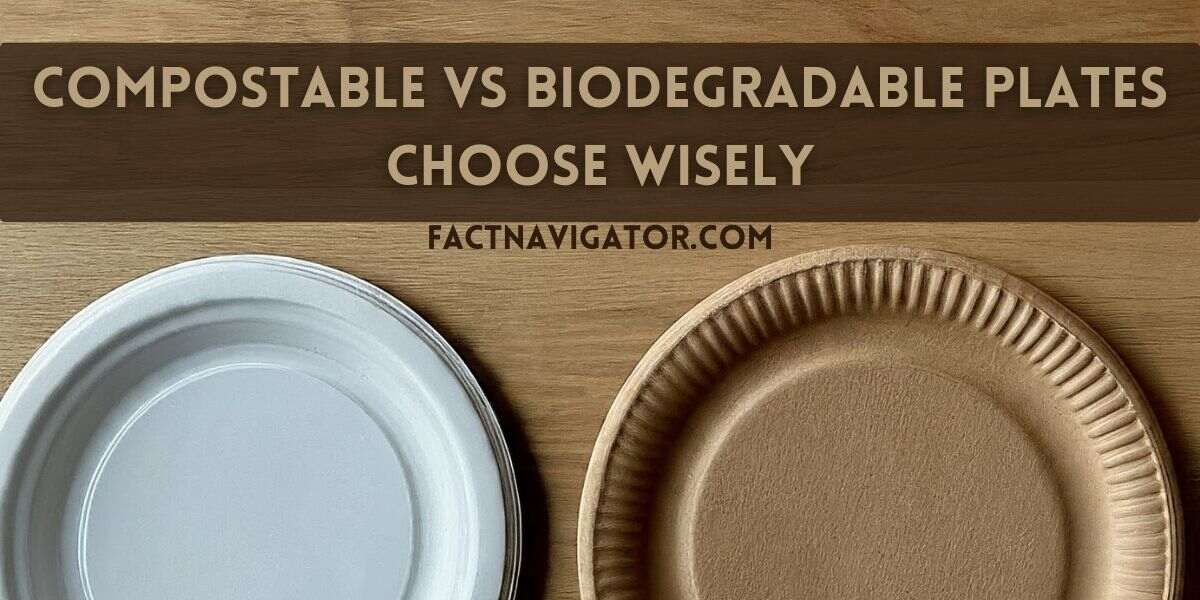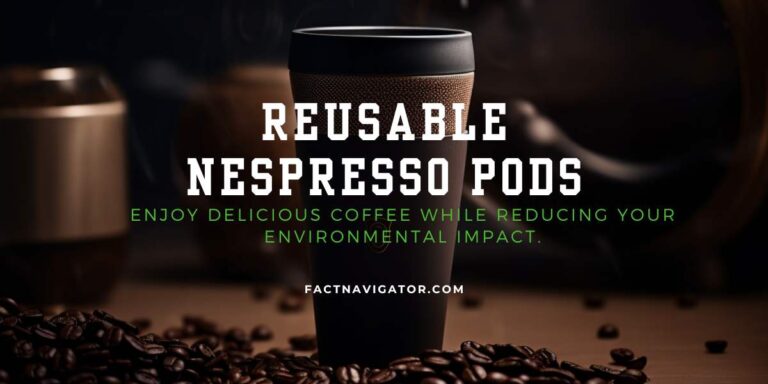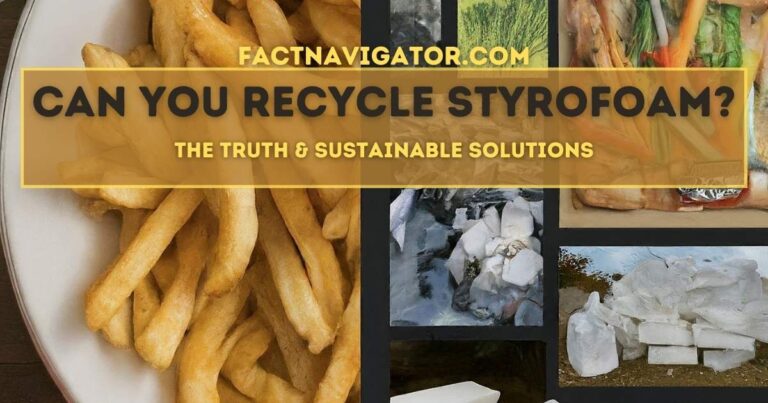Compostable vs Biodegradable Plates: Choose Wisely

Planning a party, packing a picnic lunch, or just enjoying a quick meal on the go? While disposable plates seem like a convenient option, their environmental impact often goes unnoticed. This article delves into the world of biodegradable, compostable, and paper plates, highlighting their key differences and helping you make the most eco-friendly choice for your needs. We’ll explore the hidden issues with paper plates, the benefits of biodegradable and compostable alternatives, and offer tips for responsible disposal. So, grab your fork (a reusable one, of course!) and join us on this journey towards a greener plate future!
I. The Problem with Paper Plates: Convenience with Hidden Costs
While paper plates offer undeniable convenience, their environmental impact often paints a different picture. Let’s delve deeper into the issues:
1. Not Truly Eco-Friendly
- Production Footprint: Though seemingly plant-based, paper plates often involve bleached virgin wood pulp, requiring significant water, energy, and chemicals for processing. This negates the perceived “natural” advantage.
- Non-renewable Resources: Traditional paper plates rely on trees, a finite resource. Sustainable forestry practices are crucial, but demand often outpaces responsible harvesting.
- Hidden Chemicals: Bleaching agents and coatings used in production can harm ecosystems when released during the manufacturing process or through decomposition.
2. Landfills and Litter
- Slow Decomposition: Paper plates, despite their name, don’t decompose quickly in landfills. The tightly packed fibers and lack of oxygen create an anaerobic environment, leading to slow breakdown and methane production, a potent greenhouse gas.
- Landfill Burden: Each year, billions of paper plates end up in landfills, occupying valuable space and contributing to the growing waste management crisis.
- Litter Woes: Lightweight paper plates easily escape proper disposal, ending up as litter on streets, parks, and waterways, harming wildlife and creating an unsightly mess.
3. Beyond the Plate
- Packaging and Transportation: The environmental impact extends beyond the plate itself. Consider the packaging, transportation, and associated emissions that add to the overall footprint.
- Limited Recycling: While some paper plates claim recyclability, contamination from food residue often renders them unsuitable for recycling, further increasing their environmental burden.
Paper plates offer convenience, but their hidden environmental costs are significant. Considering the production process, long decomposition times, and contribution to landfills and litter, it’s clear they aren’t the most eco-friendly option. By understanding these issues, we can make informed choices about tableware and contribute to a more sustainable future.
II. What are Biodegradable Plates? A Greener Alternative to Paper
While paper plates raise concerns, biodegradable plates offer a more sustainable solution. But what exactly are they?
Biodegradable plates are made from organic materials like sugarcane, bamboo, or palm leaves. These materials decompose naturally over time, breaking down into harmless components like water and carbon dioxide. Unlike paper plates, they don’t require harsh chemicals or rely heavily on non-renewable resources.
1. Benefits of Biodegradable Plates
- Reduced Environmental Impact: Biodegradable plates decompose naturally, minimizing their contribution to landfills and reducing greenhouse gas emissions compared to paper plates.
- Compostable Potential: Some biodegradable plates are also compostable, meaning they can break down into nutrient-rich soil amendment, further reducing waste and promoting sustainability.
- Renewable Resources: Many biodegradable plates are made from fast-growing, renewable resources like bamboo, offering a more sustainable alternative to trees used in paper production.
- Non-Toxic Materials: Biodegradable plates often avoid harmful chemicals used in paper production, making them a safer choice for both humans and the environment.
2. Examples of Biodegradable Plates
Several types of biodegradable plates are available, each with its own unique characteristics:
- Sugarcane Plates: Made from sugarcane bagasse, a byproduct of sugar production, these plates are sturdy, heat-resistant, and compostable.
- Palm Leaf Plates: Crafted from fallen palm leaves, these plates are naturally sturdy, lightweight, and compostable, offering a unique and eco-friendly option.
- Bamboo Plates: Made from rapidly renewable bamboo, these plates are durable, heat-resistant, and often compostable, contributing to a sustainable closed-loop system.
Remember, not all biodegradable plates are created equal. Some may be treated with chemicals or require specific composting conditions. Look for certifications like BPI (Biodegradable Products Institute) or ASTM D6400 to ensure your chosen plates truly decompose naturally.
By choosing biodegradable plates, you can enjoy the convenience of disposable tableware while making a conscious effort towards a greener future.
III. What are Compostable Plates? Turning Waste into Gold
While biodegradable plates offer a significant improvement over paper plates, compostable plates take eco-friendliness to another level. Let’s explore the world of compostable tableware:
Definition: Compostable plates are a specific type of biodegradable plate certified to break down completely into nutrient-rich soil amendment within a specific timeframe and under controlled composting conditions. They turn your food scraps and used plates into valuable fertilizer, closing the loop on waste and nourishing the earth.
1. Benefits of Compostable Plates
- Waste Reduction: Compostable plates divert organic waste from landfills, preventing methane emissions and contributing to a circular economy.
- Soil Health: The compost created from these plates enriches soil, improves water retention, and promotes healthy plant growth.
- Reduced Reliance on Landfills: By diverting waste from landfills, compostable plates contribute to better waste management and reduce the strain on already burdened systems.
- Sustainable Food Cycle: They seamlessly integrate into a closed-loop food system, minimizing waste and maximizing resource utilization.
2. Examples of Compostable Plates
Several types of compostable plates exist, each with unique properties:
- Biodegradable Plates with Certification: Many biodegradable plates mentioned earlier, like sugarcane, palm leaf, and bamboo plates, can also be certified compostable, meeting specific decomposition standards. Look for BPI or ASTM D6400 certifications for assurance.
- Plates Made from Food Scraps: Innovative options utilize food waste like wheat bran, oat hulls, or even fallen leaves to create compostable plates, offering a true waste-to-resource approach.
Remember: Not all compostable plates are created equal. Check for certifications and inquire about specific composting requirements to ensure they align with your local composting facilities.
By choosing compostable plates and exploring other sustainable practices, you can make a significant impact on the environment and contribute to a healthier planet.
IV. Which Plate is Right for You? Navigating the Eco-Friendly Options
Choosing the right plate goes beyond just convenience; it’s a conscious decision with environmental implications. With paper, biodegradable, and compostable options vying for your attention, navigating the eco-friendly landscape can feel overwhelming. But fret not, for this guide will equip you with the knowledge to make the best choice for you and the planet.
1. Cost Considerations
Let’s face it, budgets matter. Paper plates reign supreme in affordability, but their environmental cost outweighs the initial savings. Biodegradable plates, while more expensive than paper, offer a middle ground, balancing affordability with sustainability. Compostable plates, though pricier, represent the pinnacle of eco-friendliness, turning waste into valuable resources. Remember, the true cost goes beyond the price tag; consider the long-term environmental impact when making your decision.
2. Availability
Finding your ideal plate shouldn’t be a scavenger hunt. While paper plates are readily available everywhere, biodegradable options are gaining ground in major retailers and online stores. Compostable plates might require more searching, but eco-friendly stores and online platforms are happy to help. Remember, increased demand drives wider availability, so choose the option that aligns with your values and encourage others to do the same.
3. Biodegradability: From Slow Decay to Rapid Transformation
Biodegradability isn’t a one-size-fits-all concept. Paper plates technically degrade, but their slow decomposition in landfills contributes to harmful methane emissions. Biodegradable plates break down naturally, offering a significant improvement. However, the champion of biodegradability is the compostable plate, guaranteed to decompose quickly and completely under specific conditions, transforming waste into nutrient-rich soil amendment.
4. Composting Options: Turning Waste into Gold
Not all plates are created equal when it comes to composting. Paper plates, due to contamination concerns and slow decomposition, shouldn’t go in your compost bin. Some biodegradable plates are compostable, but remember to check for certifications like BPI or ASTM D6400. Most importantly, ensure your local composting facility accepts the specific type you choose. Compostable plates, by design, are perfect for composting, but always verify compatibility with your local facility’s requirements. Remember, composting turns waste into valuable resources, so choose plates that support this closed-loop system.
5. The Perfect Plate for You: A Balancing Act
Ultimately, the ideal plate is a personal choice based on your priorities and circumstances. For occasional use, biodegradable plates offer a good balance between affordability and environmental impact. If composting is readily available, invest in certified compostable plates to maximize waste reduction. However, when possible, prioritize reusable plates and utensils whenever feasible. Remember, minimizing disposable use is the ultimate goal.
Every conscious choice makes a difference. By understanding the trade-offs between different plate options and exploring sustainable practices, you can contribute to a greener future for our planet. So, the next time you reach for a plate, remember, it’s not just about convenience, it’s about making a positive impact on the world around us.
Also Read: What Does Biodegradable Mean For You & The Planet?
V. Maximizing the Green Impact of Biodegradable and Compostable Plates
Choosing eco-friendly plates is a commendable first step. But maximizing their environmental impact requires navigating beyond the initial purchase. Here are some key tips to ensure your biodegradable and compostable plates truly live up to their green potential:
- Certification Confidence: Not all plates labeled “biodegradable” are created equal. Look for certifications like BPI (Biodegradable Products Institute) or ASTM D6400. These certifications guarantee the plates meet specific biodegradation standards, ensuring they break down completely and responsibly.
- Compost Facility Compatibility: Before your plates embark on their composting journey, do your research! Not all facilities accept biodegradable or compostable materials. Contact your local composting facility to confirm their accepted materials list and any specific requirements they might have.
- The Home Composting Option: If you have a home compost bin, you’re in luck! Many biodegradable and compostable plates can be composted right at home, turning your food scraps and plates into nutrient-rich soil amendment. Remember to follow your compost bin’s specific guidelines for acceptable materials and proper layering techniques.
- Recycling as a Last Resort: While not the ideal scenario, some facilities accept composted plates for recycling if composting isn’t an option. This allows the materials to be repurposed into new products, further minimizing waste. However, remember that recycling should be the last resort after exploring composting possibilities.
- Beyond the Plate: Remember, the eco-conscious journey goes beyond plates alone. Consider these additional tips:
- Opt for reusables: Whenever possible, prioritize reusable plates and utensils over disposables. This minimizes waste generation and conserves resources.
- Reduce single-use items: Look for ways to minimize your overall use of disposable items, such as using cloth napkins instead of paper napkins or carrying your own reusable water bottle.
- Educate others: Share your knowledge about eco-friendly alternatives with friends and family. Encouraging others to make conscious choices creates a ripple effect for a healthier planet.
By following these tips, you can ensure your biodegradable and compostable plates truly fulfill their eco-friendly promise. Remember, every small step towards sustainability, from choosing the right plate to reducing overall waste, contributes to a greener future for us all. Let’s work together to make every plate a celebration of both convenience and environmental responsibility!
VI. The Environmental Impact of Different Plates
| Feature | Paper Plates | Biodegradable Plates | Compostable Plates |
|---|---|---|---|
| Resource Usage | Virgin wood pulp (deforestation) | Renewable resources (bamboo, sugarcane) | Renewable resources (bamboo, sugarcane) |
| Chemicals | Bleaching agents, potential health risks | Reduced chemical footprint | Reduced chemical footprint |
| Decomposition | Slow, releases methane in landfills | Natural decomposition, minimizes methane | Certified rapid and complete breakdown |
| Recycling | Limited due to food residue contamination | Not applicable | Not applicable |
| Carbon Footprint (per 1000 plates) | 32 kg CO2e | 14 kg CO2e | 8 kg CO2e |
| Benefits | Convenient, readily available | More sustainable than paper, natural decomposition | Minimizes waste, turns waste into fertilizer, enriches soil |
| Drawbacks | High environmental impact, hidden costs | Less readily available, higher cost | Less readily available, higher cost, requires composting access |
| Best Use | Occasional use only | Moderate use, when composting not available | Frequent use, when composting available |
| Sustainable Alternative | Reusable plates and utensils | Reusable plates and utensils, compostable plates when needed | Reusable plates and utensils, prioritize composting |
VII. Turn Waste into Gold: Composting Your Plates at Home
Embracing compostable plates is a fantastic step towards sustainability, but the journey doesn’t end there! Composting them at home transforms your used plates into nutrient-rich soil amendment, closing the loop and nourishing your garden. Here’s how to turn your plates into “green gold”:
- Know Your Bin: First things first, ensure your compost bin accepts the specific type of plate you’re using. Check the bin’s guidelines or contact the manufacturer for confirmation. Some bins might have limitations on accepted materials, so it’s crucial to verify compatibility.
- Shred it Up: Tear your used plates into smaller pieces. This increases surface area, promoting faster decomposition by microbes in your compost bin. Think of it as giving the microbes more “food” to break down efficiently.
- Balance is Key: Composting thrives on a balanced mix of “green” (nitrogen-rich) and “brown” (carbon-rich) materials. While your plates contribute some carbon, remember to add other brown materials like shredded leaves, cardboard, or twigs. This ensures proper aeration and moisture levels for optimal decomposition.
- Temperature Matters: Like tiny chefs, microbes work best in warm environments. Aim for a compost bin temperature between 50-60°C (122-140°F). If your bin struggles to maintain this range, consider adding a compost activator or turning it regularly to aerate and generate heat.
- Patience is a Virtue: Composting takes time, typically 2-3 months depending on factors like temperature, moisture, and material composition. Be patient and don’t peek too often; disturbing the process can slow down decomposition.
- Reap the Rewards: Once your plates have fully decomposed, you’ll have nutrient-rich compost ready to nourish your garden! Use it to amend your soil, add to potted plants, or start a new compost pile. Remember, you’ve successfully turned waste into valuable fertilizer, contributing to a greener future.
Bonus Tips:
- Compost kitchen scraps alongside your plates: This adds valuable nitrogen to the mix and maximizes your composting efforts.
- Invest in a compost thermometer: Monitoring temperature helps you ensure optimal conditions for decomposition.
- Layer your compost bin properly: Alternate between green and brown materials for efficient breakdown.
- Enjoy the process: Composting is a rewarding experience! Witnessing waste transform into valuable resources is a powerful reminder of our connection to nature.
By composting your plates at home, you’re not just disposing of waste; you’re creating a valuable resource and contributing to a more sustainable future. So, grab your plates, get composting, and witness the magic of turning waste into gold!
VIII. Where to Buy Biodegradable and Compostable Plates
As the demand for eco-friendly alternatives grows, finding biodegradable and compostable plates becomes increasingly easier. Here are some options to explore:
1. Online Retailers
- Amazon: A vast selection of both biodegradable and compostable plates from various brands. Be sure to check certifications and compostability requirements before purchasing.
- Etsy: Supports small businesses and often offers unique, handcrafted compostable plates made from materials like bamboo or fallen leaves.
- Eco-conscious online stores: Many online stores specialize in sustainable products, offering a curated selection of certified biodegradable and compostable plates. Examples include World Centric, Green Paper Products, and Biodegradable Foodservice.
- Compostable packaging companies: Some companies that specialize in compostable packaging materials also offer plates as part of their product line. Look for brands like BPI certified and AIB certified.
2. Physical Stores
- Natural food stores: Often stock eco-friendly products, including biodegradable and compostable plates.
- Grocery stores: While selection might be limited, some larger grocery stores are starting to carry these options. Look for brands like Eco Products or Bioplate.
- Home improvement stores: Stores like Home Depot or Lowe’s might carry compostable plates in their garden section.
- Local farmers markets: Support local businesses and find unique, handcrafted compostable plates made from sustainable materials.
3. Additional Tips
- Consider buying in bulk: Purchasing larger quantities can sometimes be more cost-effective, especially for online retailers.
- Look for deals and promotions: Many stores offer discounts on eco-friendly products, so keep an eye out for sales.
- Support local businesses: When possible, choose plates made by local companies to minimize transportation emissions.
- Remember reusables: While biodegradable and compostable plates are a great option, remember that reusables are the most sustainable choice whenever possible.
By choosing biodegradable and compostable plates, you’re making a conscious effort to reduce your environmental impact. With the growing availability of these options, making the switch is easier than ever. So explore the different options, find what works best for you, and enjoy your meals knowing you’re doing your part for a greener planet!
IX. Conclusion: Choosing Your Plate, Choosing the Planet
Our journey through the world of paper, biodegradable, and compostable plates has hopefully unveiled the crucial link between our everyday choices and the health of our planet. While convenience often dictates our decisions, understanding the hidden environmental costs of paper plates empowers us to make informed choices. Biodegradable and compostable options offer a more sustainable path, but the ultimate goal lies in minimizing disposable use altogether.
1. The Importance of Eco-Friendly Plates
Every plate we use tells a story – a story about our values, our relationship with nature, and the legacy we leave behind. By choosing eco-friendly plates, we become active participants in shaping a healthier future. We minimize landfill waste, reduce greenhouse gas emissions, and contribute to a circular economy where resources are used and reused responsibly.
2. Beyond the Plate: Reducing Your Impact
Remember, the plate is just one piece of the puzzle. Here are some additional tips to further reduce your environmental impact:
- Embrace reusables: Whenever possible, prioritize reusable plates, utensils, and containers. This minimizes waste generation and conserves resources.
- Reduce single-use items: Explore ways to minimize your reliance on disposable items beyond plates. Use cloth napkins, carry your own water bottle, and opt for reusable shopping bags.
- Support sustainable businesses: Choose brands committed to ethical and sustainable practices. Look for certifications like Fair Trade, B Corp, or USDA Organic.
- Compost food scraps: Turn your food scraps into valuable soil amendment by composting at home or supporting local composting initiatives.
- Spread awareness: Share your knowledge about sustainable practices with friends and family. Encourage them to make conscious choices and join the movement towards a greener future.
3. The Power of Choice
Every decision we make, big or small, contributes to the world we create. By choosing eco-friendly plates, reducing our reliance on disposables, and supporting sustainable practices, we collectively have the power to create a more positive and sustainable future. Let’s make every plate a symbol of our commitment to a healthier planet, one delicious bite at a time!





